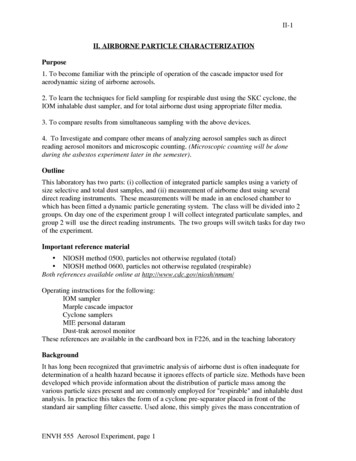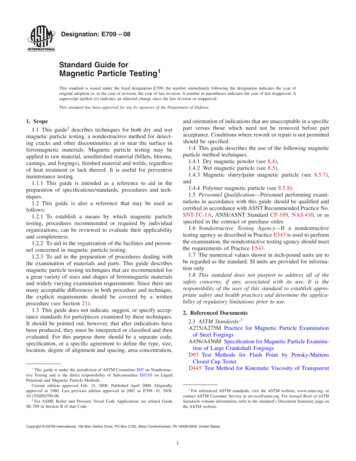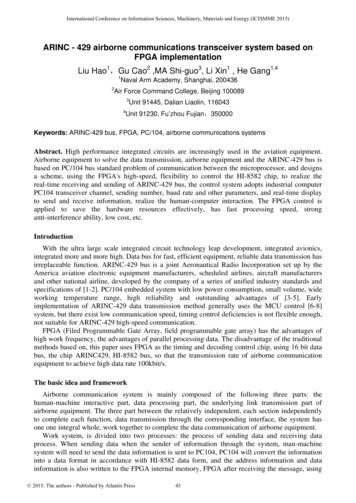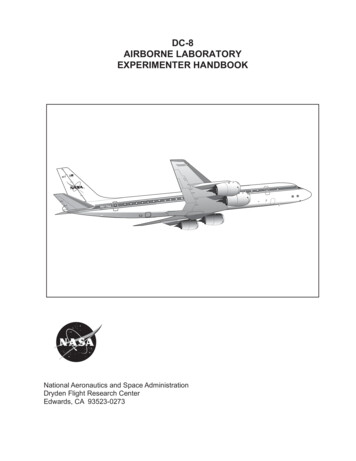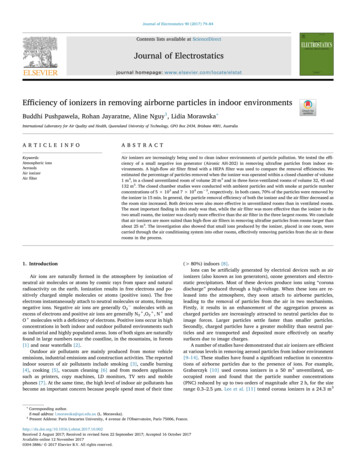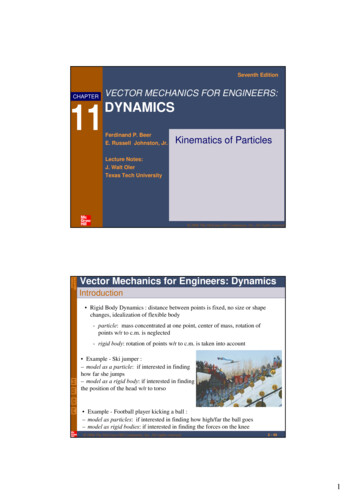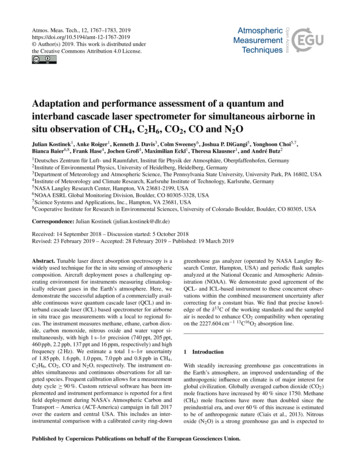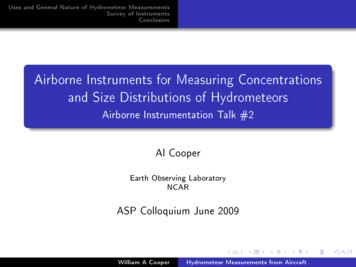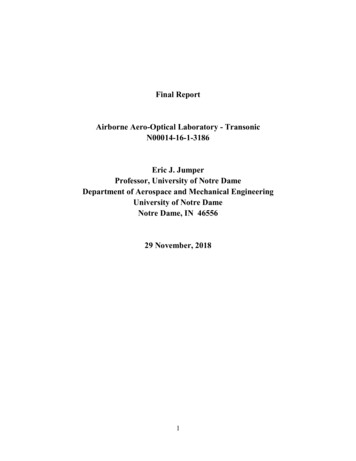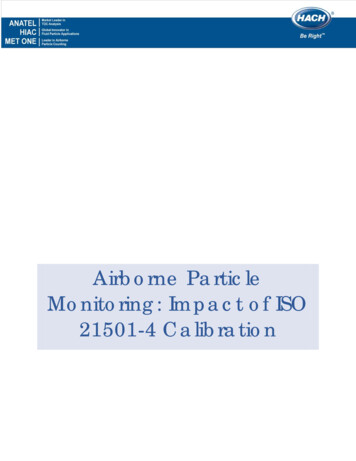
Transcription
Airborne ParticleMonitoring: Impact of ISO21501-4 Calibration
Airborne Particle Monitoring: Impact of ISO 21501-4 Calibration Airborne Particle Monitoring: Impact of ISO 21501-4CalibrationAbstract:Dependable, consistent and repeatable results in monitoring airborne particles in cleanrooms and cleanzones depends both on the sampling technique of the analyst and on the performance of the particlecounting instrument. The control of the sampling technique often is the subject of a unique SOP(Standard Operating Procedure) while the performance of the instrument is typically reviewed andverified through an annual or semi-annual calibration processThe calibration process itself has been subject to a greater degree of variability in actual practice andthroughout the lengthy life of the instrument than would be desired, due to different calibrationtechniques magnified by infrequent maintenance and calibration. This variability can be minimized bythe implementation of the ISO 21501-4 calibration standard. Although there will be additional time andcost in the calibration process, the end result will be a noteworthy improvement in repeatability over thelifetime of the instrument and also improvement in reproducibility between instruments.“The purpose of this part of ISO21501 is to provide a calibrationprocedure and verification method forparticle counters, so as to minimizethe inaccuracy in the measurementresult by a counter, as well as thedifferences in the results measuredby different instruments.”Translation:What you’ll get if you use ISO 21501-4methods:1. Better repeatability over thelifetime of the instrument2. Better agreement betweenInternational standards for the monitoring of airborne particlesare used by all industries that employ cleanrooms or cleanzones. Some form of airborne sampling for particles isneeded for these controlled environments in order to ensurethe quality of the product being manufactured or the successof the process that is being conducted in this controlled orcritical environment. Many variables will affect the success ofthe operations in these areas; the particulate levels in the airare often a significant element in the control of the risk offailure (or, inversely, the likelihood of success!) for thecontrolled operation.The initial standard for classification of clean rooms and cleanzones from the United States, known as “Federal Standard209E”, had a global impact for many years but was officiallyreplaced in 1999 by a new global standard, ISO 14644-1.Abstract: 1
Airborne Particle Monitoring: Impact of ISO 21501-4 Calibration Proposed wording of Paragraph A2.2Revision of ISO 14644-1 and -2in the normative Appendix A:(TC209 Working Group 1)For the past several years, an international committee known asTC209 Working Group 1 (WG1) has been examining potentialrevisions to the first two sections of the ISO 14644 document. Theinitial general vote on the proposed revisions by the larger body ofnations was in May 2011; changes were proposed and a re-draft is inprocess. A new DIS should appear in 2013, followed by a release andeffective date of the revision in 2014.One key change in the proposed revision of ISO 14644-1 is thenormative reference to a calibration standard for the instrument to beused for cleanroom classification. Previously, no mention of acalibration method had been made in ISO 14644-1.A.2.2 Instrument calibrationThe instrument shall have a validcalibration certificate; thefrequency and method ofcalibration should be based oncurrent accepted practice asspecified in ISO 21501-4:2007.But it is well-known that the variability of the calibration techniques or methods can have a significanteffect on the performance of a particle counting instrument and on the reproducibility betweeninstruments.The Ultimate QuestA common expectation for customers havingmultiple particle counting instruments that eachinstrument would give the same result as any otherwhen sampling in the same physical space. This isan unrealistic hope, due to the reality that the sameaerosol cannot be simultaneously or evensequentially sampled by a pair of instruments. Theparticle levels in a room or zone are highly variableover time, depending on activity, number ofpersonnel, speed of activity (even walking),temperature gradients, and changes in air flow rates- to name just a few of the variables. Airborneparticle counts in an active area could be comparedto counting cars on a road or freeway: each samplemight be quite valid for the time it was taken but thenumbers one might obtain during the middle of thenight could be markedly different than thoseobtained at the peak of the commute hours! Addinto this any concern with the reliability of theinstrument being used, and the effort to define theairborne particle levels becomes even morechallenging!!!Abstract: 2
Airborne Particle Monitoring: Impact of ISO 21501-4 Calibration Controlling variability between instruments through ISO 21501-4The variability of the concentration of airborne particles is a matter of cleanroom design coupled withthe control of the process and activities with the clean zone whereas the variability of the measuringinstrument is one of calibration, proper use and maintenance. ISO 21501-4 provides a thoroughplatform to gain control of the potential variability of the instruments. In many cases, calibrations of aninstrument done in the years following its initial manufacture could take many forms. Stories abound of1-point “calibrations” performed by independent or unqualified contractors with little or no traceability tonational standards organizations such as NIST, DANAK, BSI, DIN, JIS, etc. Methods also variedbetween different instrument manufacturers. Most calibrations done by qualified technicians in the fieldcan often consist of only 3 or 4 tests. When a calibration is performed following ISO 21501-4, typicallyat least 8 different tests are executed. These tests require both additional time and additionalequipment. Although calibration according to ISO 21501-4 will likely create some additional cost incomparison to what is currently performed, there will be noteworthy benefits in both the repeatabilityand the reproducibility of measurements obtained.ISO 21501-4 ParametersTarget LimitSize Calibration 5%Counting Efficiency at First Channel50% 20%Counting Efficiency at particle Size 1.5 to 2 times First Channel100% 10%Instrument Resolution (at the size specified by manufacturer) 15%Zero Count test 1 count in 5 minsMaximum particle number concentration (specified by manufacturer) 10%Sampling Flow Rate (volumetric) 5%Sampling Time 1%Calibration Interval 1 yearRepeatability refers to the stability of the values obtained by a given instrument when taking multiplemeasurements of the same environment with a consistent particulate level. Reproducibility refers to theability of two or more instruments to obtain the same results when measuring the same environmentwith a consistent particulate level.As noted previously, it is almost impossible to have a consistent level of airborne particulates in anenvironment in the real world so the variation of readings from one instrument taking consecutivereadings, or between two instruments taking parallel readings, will always exist.What ISO 21501-4 provides is verification that under controlled circumstances and in testing acontrolled and consistent aerosol, the instrument can provide predictable and consistent readings.Abstract: 3
Airborne Particle Monitoring: Impact of ISO 21501-4 Calibration This process thus creates the basis for confidence that the readings obtained “in the real world” - withits inherent variability - will be a true reflection of the contamination level at a given moment.ResourcesDirect assistance: contact ISO 21501 Support at iso21501@hach.comFor assistance in auditing your particle counter fleet,1. Request a more detailed review of ISO 21501-4 Whitepaper: ISO-21501-4: Calibration of Air Particle Counters from a MetrologyPerspective (Latimer and Ping)2. Request additional information on ISO 21501 Whitepaper: ISO 21501 – A Standard Methodology to Optical Particle CounterCalibration and What it Means to Cleanroom Owners. Whitepaper: Optical Particle Counters and Counting EfficiencyPublished articles: Gecsey, J. Airborne Particle Monitoring: Satisfying the Changing Demands in Regulations andMethods, Cleanrooms Magazine, September 2009, pages 14-18 Harrison, T., ISO 21501 - A Standard Methodology to Optical Particle Counter Calibration andWhat it Means to Cleanroom Owners, The Cleanroom Monitor, August 2009, Issue 61, TheScottish Society for Contamination Control, New Support for ISO 14644-1About the AuthorJoe Gecsey is the Life Sciences Application Manager at HACH in Grants Pass,Oregon, USA. He is responsible for tracking regulatory changes regardingparticulate counting in the Life Science industry and is one of two USrepresentatives on the TC 209 Working Group (WG1) tasked with finalizing therevisions to ISO 14644-1 and 14644-2. He has conducted seminars throughoutthe world on particle counter design and applications. He received a Bachelor ofScience degree in Electronic Engineering from the University of California in 1974and has been employed as an engineer and technical advisor by Hach (previouslyMet One) since 1984.He can be reached by telephone at: 1 541 472 6526 or by email: mailto:jgecsey@hach.com.Mailing address: HACH, 481 California Avenue, Grants Pass, Oregon 97526 USAVisit us on www.particle.com for additional product informationDirect assistance: contact ISO 21501 Support at iso21501@hach.com 4
One key change in the proposed revision of ISO 146441 is the - normative reference to a calibration standard for the instrument to be used for cleanroom classification. Previously, no mention of a calibration method had been made in ISO 14644-1. But it is well-known that the variability of the calibration techniques or methods can have a .
